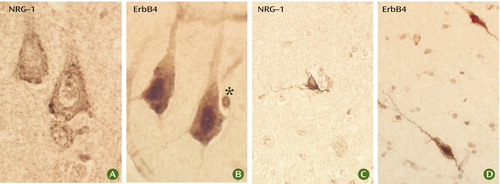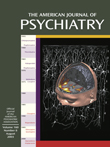Schizophrenia, IV: Neuregulin-1 in the Human Brain
Human genes are being identified that confer a risk of schizophrenia to individuals. Because proteins derived from these genes are identified through genetic analysis, the level of preexisting knowledge about their distribution and function is often minimal. Neuregulin-1 (NRG-1) was identified as a susceptibility gene for schizophrenia within the Icelandic DNA repository. Moreover, mutant mice heterozygous for NRG-1 or its receptor ErbB4 show behaviors reminiscent of mouse models of schizophrenia. The neuregulin system participates in the regulation of cell survival, proliferation, migration, and differentiation of both neurons and glia. Both proteins are highly expressed in the mature and developing brain and are localized to the synapse. Unfortunately, the function of NRG-1 and ErbB4 is not fully clarified in the human brain. Along with our collaborators at the NIMH Clinical Brain Disorders Branch, we have been examining the anatomic distribution of NRG-1 and ErbB4 in an attempt to develop an understanding of their roles in brain function. This knowledge will underlie our ultimate goal of defining how genetic differences can predispose individuals to schizophrenia. Using immunohistochemistry with polyclonal antibodies directed against NRG-1 and ErbB4, we examined the distribution of these two proteins in several regions of the adult human brain. These proteins are present in widespread areas of the brain, including the frontal cortex, hippocampus, midbrain, and cerebellum. NRG-1 and ErbB4 are expressed in numerous brain cells, including pyramidal neurons, nonpyramidal neurons, and, to a lesser extent, glia. The figures show NRG-1 and ErbB4 protein expression in pyramidal neurons, satellite glia, and white matter neurons of the dorsolateral prefrontal cortex, an area implicated in the pathophysiology of schizophrenia. Studies to define the distribution and levels of this protein in schizophrenia tissue as well as in healthy comparison subjects are underway.
Address reprint requests to Dr. Tamminga, UT Southwestern Medical Center, Department of Psychiatry, 5323 Harry Hines Blvd., #NC5.914, Dallas, TX 75390-9070; [email protected] (e-mail). Image courtesy of Dr. Law.

Figures.
Localization of NRG-1 and ErbB4 protein expression in pyramidal neurons (A and B) and white matter neurons (C and D) in the dorsolateral prefrontal cortex. The asterisk denotes ErbB4 expression by a closely associated satellite glia.



